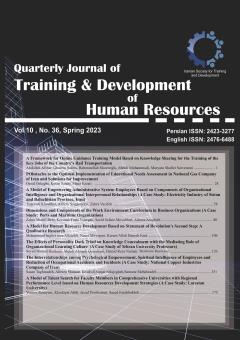-
-
List of Articles
-
Open Access Article
1 - A Framework for Online Guidance Training Model Based on Knowledge Sharing for The Training of the Key Jobs of the Country's Rail Transportation
abdulah afshar ghasem salimi rahmatallah marzooghi mehdi mohammadi Maryam Shafiei Sarvestani -
Open Access Article
2 - Obstacles to the Optimal Implementation of Educational Needs Assessment in National Gas Company of Iran and Solutions for Improvement
omid oshaghi Mitra Ezati keyvan salehi -
Open Access Article
3 - A Model of Empowering Administrative System Employees Based on Components of Organizational Intelligence and Organizational Interpersonal Relationships (A Case Study: Electricity Industry of Sistan and Baluchistan Province, Iran)
Fatemeh khoshhal Alireza sargolzaie Zahra Vazife -
Open Access Article
4 - Dimensions and Components of the Work Environment Curriculum in Business Organizations (A Case Study: Ports and Maritime Organization)
zahra sharifiblue Kurosh Fathi Vajargah Saeid Safaei Movahhed علیرضا عراقیه -
Open Access Article
5 - A Model for Human Resource Development Based on Statement of Revolution’s Second Step:A Qualitative Research
Mohammad bagher Reza alizadeh Naser Mirsepassi Karam alah danehfard -
Open Access Article
6 - The Effects of Personality Dark Triad on Knowledge Concealment with the Mediating Role of Organizational Learning Culture (A Case Study of Tehran University Professors)
seyed hamed hashemi mehdi ahmadighamshani Hamidreza Nematollahi shabnam zarjou -
Open Access Article
7 - The Interrelationships among Psychological Empowerment, Spiritual Intelligence of Employees and Reduction of Occupational Accidents and Incidents (A Case Study: National Copper Industries Company of Iran)
sasan Taghizadeh Alireza Manzari Tavakoli Sanjar Salajegheh samaneh mehdizadeh -
Open Access Article
8 - A Model of Talent Search for Faculty Members in Comprehensive Universities with Regional Performance Level based on Human Resources Development Strategies (A Case Study: Lorestan University)
unes romiani Khodayar abili javad porkarimi saeid frahbakhsh
-
The rights to this website are owned by the Raimag Press Management System.
Copyright © 2017-2026







